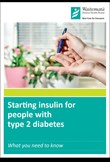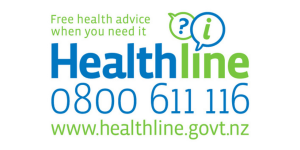Insulin overview
Key points about insulin
- Insulin is used to treat diabetes.
- There are different brands of insulin available in Aotearoa New Zealand and these are grouped by the time it takes for the insulin to work.
- Find out how to use insulin safely and possible side effects.

There are a variety of different insulins available in Aotearoa New Zealand and they are grouped by the time it takes for the insulin to work.
Rapid-acting insulin
Rapid-acting insulin usually works straight away, so it's injected just before or with food. Its effect lasts 1 to 2 hours.
Examples include:
- NovoRapid (also called insulin aspart)
- Apidra (also called insulin glulisine)
- Humalog (also called insulin lispro)
Short-acting insulin
Short-acting insulin usually works within 15 to 20 minutes, so you inject each dose 15 to 20 minutes before you eat. Its effect lasts 3 to 4 hours.
Examples include:
- Actrapid
- Humulin R
- They are also called human neutral insulin or soluble insulin.
Intermediate and long-acting insulin
Intermediate and long-acting insulin usually works after about 1 hour. Its effect lasts all day and it may be injected once or twice a day.
Examples include:
- Lantus (also called insulin glargine)
- Protaphane (also called isophane insulin)
- Humulin NPH (also called isophane insulin).
Premixed insulin
These insulins are a mixture of short and intermediate-acting insulins or short and long-acting insulins. These may be injected 2 or 3 times a day, in the morning, before breakfast and before dinner. Premixed insulin must be injected before dinner, rather than before bedtime. Premixed insulin is also called biphasic insulin.
Examples include:
- NovoMix 30 FlexPen
- PenMix 30, PenMix 50
- Humulin 30/70
- Mixtard 30
- Humalog Mix 25, Humalog Mix 50
- Ryzodeg
Availability of premixed insulins in Aotearoa New Zealand
- Ryzodeg will be funded from 1 May 2025. Ryzodeg is a combination of a long-acting and a rapid-acting insulin. It helps manage blood glucose levels throughout the day and may be a suitable alternative to Novomix 30.
- Mixtard 30, PenMix 30 and PenMix 50 won't be available in Aotearoa New Zealand from November 2024.
- NovoMix 30 FlexPen will be gradually discontinued. Supplies are expected to run out by mid 2026. People using these products will need to talk to their prescriber as soon as possible about moving to another insulin.
Read more about the insulin isophane with insulin neutral discontinuation(external link).
Insulin can be injected using a range of devices such as insulin syringes, insulin pens and insulin pumps.
Insulin syringes
- There are 3 different-sized insulin syringes available in Aotearoa New Zealand: 0.3 mL, 0.5 mL and 1 mL.
- The strength of all funded insulin in Aotearoa New Zealand is 100 units/mL, so a 0.3 mL syringe has doses of up to 30 units.
- Syringes can be useful if you need to take 2 different types of insulin mixed in different amounts.
- They're also useful for giving insulin to young children when insulin isn't available as an insulin pen.
- Needles are attached to the syringes. Needles are available in different sizes and are measured by their thickness (gauge or G) and their length (in mm), eg, 31 gauge x 8 mm.
- Read more about insulin syringes and needles.
Insulin pens
Insulin pens are similar in size and shape to a writing pen. They make measuring and injecting your insulin easier,
- Most pens hold 300 units of insulin and allow delivery of up to 60 to 80 units at a time.
- Most insulins are available as pens. There are 2 types – reusable pens and disposable pens.
- Read more about insulin pens.
Insulin pumps
- An insulin pump is a small battery-operated device, mainly used by people with type 1 diabetes.
- It can be used to deliver insulin to match your body’s needs.
- Insulin pumps consist of the pump itself, a disposable reservoir to store the insulin, and a disposable infusion set.
- Read more about insulin pumps.
Insulin dose and timing
- Your healthcare provider will work with you to find the best insulin type to meet your needs.
- If you have type 1 diabetes, your diabetes is managed with insulin only. You need daily injections of insulin to keep your blood glucose levels under control.
- If you have type 2 diabetes, and you're on insulin, you may use insulin together with tablets to manage your blood glucose levels, or you may use insulin alone.
- The timing of your insulin in relation to food and exercise is important. Your healthcare provider will advise you when it's best to use your insulin.
- It's best to avoid hot showers or baths within 30 minutes of an insulin dose.
- Your healthcare provider will advise what to do if you miss a dose of insulin.
Choosing an injection site
- Insulin should be injected into the fatty tissue under your skin. Commonly used sites are the tummy area, thighs and buttocks – your tummy area is usually preferred.
- You need to change injection sites so that your skin doesn't get lumpy. Lumpy skin can affect how your body absorbs insulin.
- It's important not to inject insulin into any scar tissue.
- Read more about insulin injection sites.
If you're unwell and not eating
- If you are unwell, such as with vomiting (being sick) or diarrhoea (runny poo), and you're not eating as you usually do, your insulin dose may need to be changed.
- It's important to plan ahead for sick days and work with your diabetes team to create a sick day plan.
- Read more about sick day plans for type 1 diabetes and sick day plans for type 2 diabetes.
It's very important that insulin is stored correctly. Incorrectly stored insulin can stop it from working properly.
- Unopened insulin can be stored in the fridge until it's used.
- Do not store insulin in the freezer.
- Once opened, insulin vials, cartridges or pre-filled pens can be kept at room temperature but must be discarded after 4 weeks.
- When you're keeping insulin in use at room temperature, ensure it is not exposed to sunlight.
Read more about storing and handling insulin.
In this section you will find videos on:
- Drawing up insulin
- How to use an insulin pen
- Giving the first injection
- Giving an insulin injection to a toddler
- Using a log book to record blood glucose levels
- Supporting your child with diabetes
- Disposal of needles
Video: Drawing up insulin
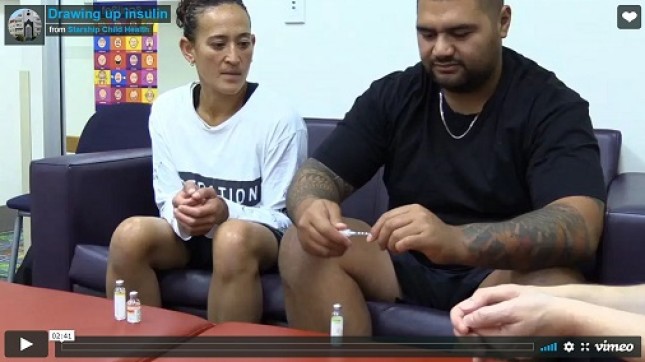 (external link)
(external link)
(Starship Children's Health, NZ)
Video: How to use an insulin pen
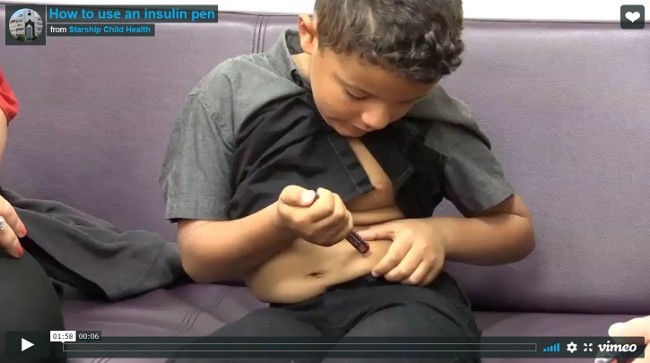 (external link)
(external link)
(Starship Children's Health, NZ)
Video: Giving the first injection
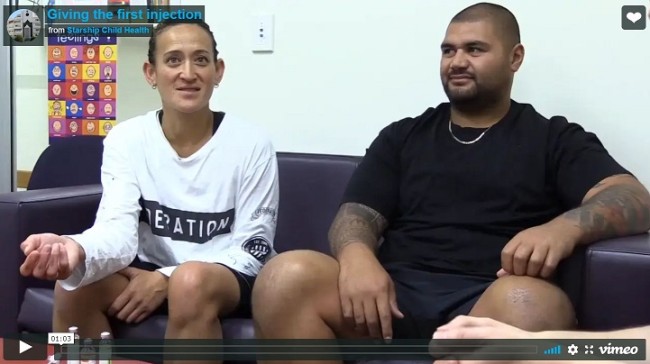 (external link)
(external link)
(Starship Children's Health, NZ)
Video: Giving an insulin injection to a toddler
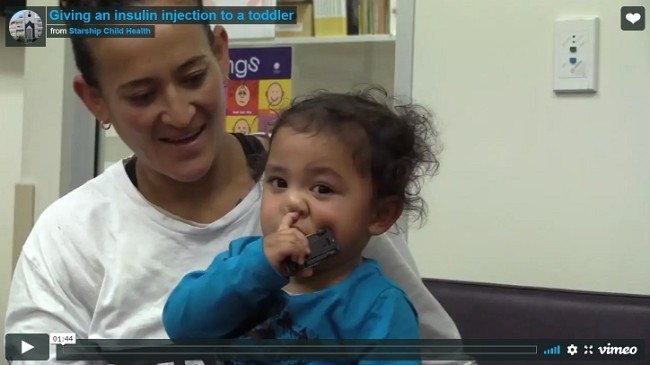 (external link)
(external link)
(Starship Children's Health, NZ)
Video: Using a log book to record blood glucose levels
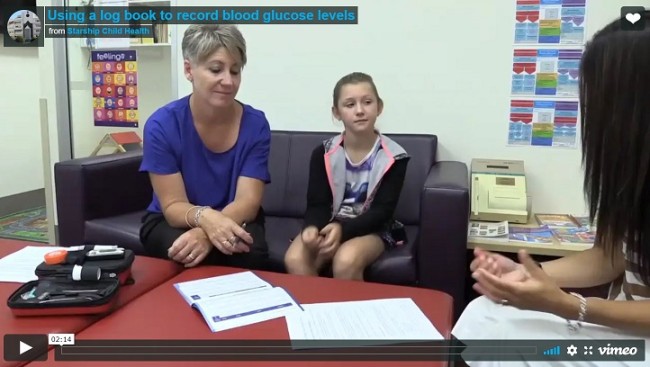 (external link)
(external link)
(Starship Children's Health, NZ)
Video: Supporting your child with diabetes
 (external link)
(external link)
(Starship Children's Health, NZ)
Video: Disposal of needles
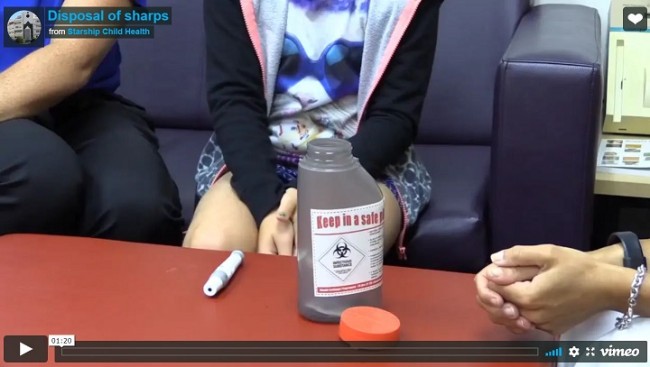 (external link)
(external link)
(Starship Children's Health, NZ)
Consumer guide to insulin pen needles(external link) Diabetes NZ
Insulin injections(external link) Starship Children's Health, NZ
Managing diabetes in children and young people (for families)(external link) Starship Children's Health, NZ
New Zealand Formulary Patient Information:
- Insulin aspart(external link) (te reo Māori(external link))
- Insulin detemir(external link) (te reo Māori(external link))
- Insulin glargine(external link) (te reo Māori(external link))
- Insulin glulisine(external link) (te reo Māori(external link))
- Insulin isophane(external link) (te reo Māori(external link))
- Insulin lispro(external link) (te reo Māori(external link))
- Insulin neutral(external link) (te reo Māori(external link))
- Insulin neutral and isophane(external link) (te reo Māori(external link))
Starting insulin for people with type 2 diabetes(external link) SafeRx, Waitematā DHB, NZ Chinese, (external link)English, (external link)Korean, (external link)Samoan, (external link)Tongan(external link)
(external link)How to use your insulin pen [PDF, 320 KB] Waitemata DHB, NZ, 2020
Diabetes and insulin(external link) Diabetes New Zealand, 2019
Brochures
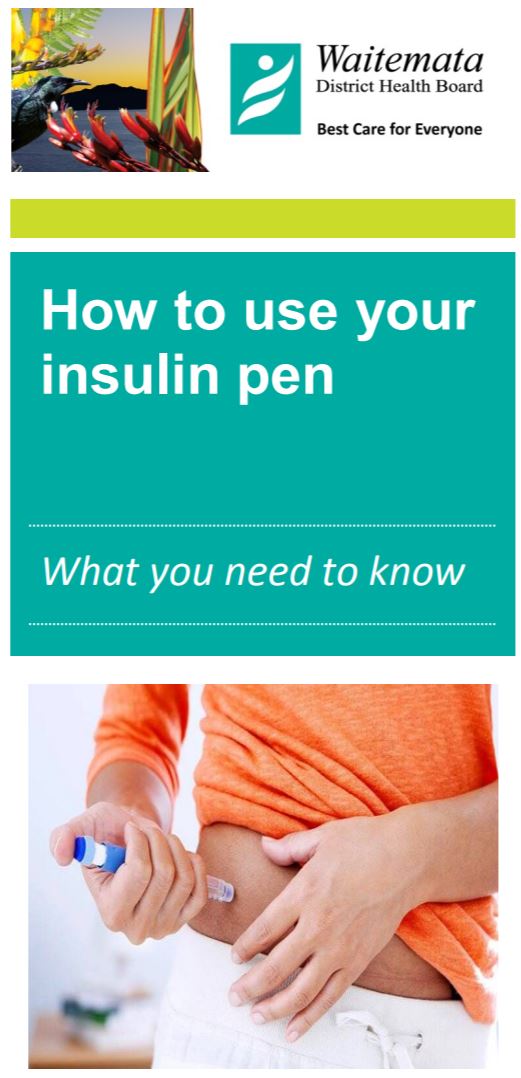
Waitemata DHB, NZ, 2020
Credits: Sandra Ponen, Pharmacist, Healthify He Puna Waiora. Healthify is brought to you by Health Navigator Charitable Trust.
Reviewed by: Angela Lambie, Pharmacist, Auckland
Last reviewed:


